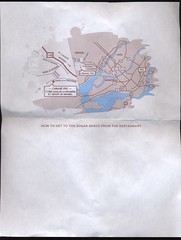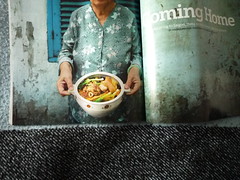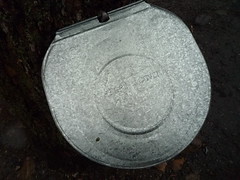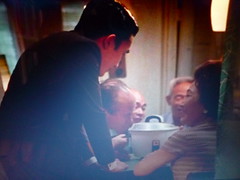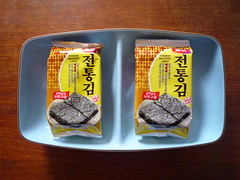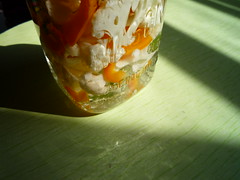Qing wha'? Qing Hua! 2nd rev. ed.
 fig. a: the remains of the soup
fig. a: the remains of the soup
"Soupes raviolis."
Yes, that's what the window reads: soupes raviolis. We'd seen the sign before, but didn't realize soupes raviolis = dumpling heaven.
Qing Hua is a tiny little shopfront establishment that sits in the basement of a building at the corner of St-Marc and Tupper. There's seating for maybe 20. The menu consists entirely of three options: dumplings, salads, and soups. The dumplings make up about 90% of the menu and are the star attraction. To emphasize this point a bilingual placard on the wall explains in just a few short words the long and glorious history of the Chinese dumpling.
 fig. b: 1400 years' history
fig. b: 1400 years' history
Dumpling options are broken down into three categories: vegetarian/seafood, seafood/seafood with meat, and pork/beef/lamb. Orders range in price from $6.49 to $13.99 and contain about 18-20 dumplings (we didn't bother counting because, frankly, we just couldn't wait to dig in). We'd been told that an order of the beef noodle soup with fresh, hand-pulled noodles was a must, but apparently the folks at Qing Hua won't be offering the beef noodle soup for about a month, because the chef suffered a noodle-related injury (we didn't ask too many questions). So we went with the wonton soup instead, and it was a stunner. You see, it's all about the dumplings, and at Qing Hua every single dumpling is made to order. When our orders of freshly steamed pork & cabbage and pork & shrimp dumplings arrived we nearly cried. Our favorites were the shrimp & pork dumplings--each of them contained a whole shrimp, and they were a little brothier than their siblings. We recommend having them with the Chinkiang vinegar and a few droplets of the chili oil from the fixin's bar.
 fig. c: the menu
fig. c: the menu
Afterwards, we noticed a FOR RENT sign in a window just down the street. It was only a 3 1/2--probably a little tight for the two of us plus our two beloved cats--but we looked at one another and said the exact same thing: "We could get take-out! All the time!"
Qing Hua Dumpling, 1240 St-Marc, (438) 288-5366
Note: Qing Hua has moved. They're now at 1676 Lincoln Ave. (near Guy). The phone # remains the same. So does the quality. They're just as good as ever.
